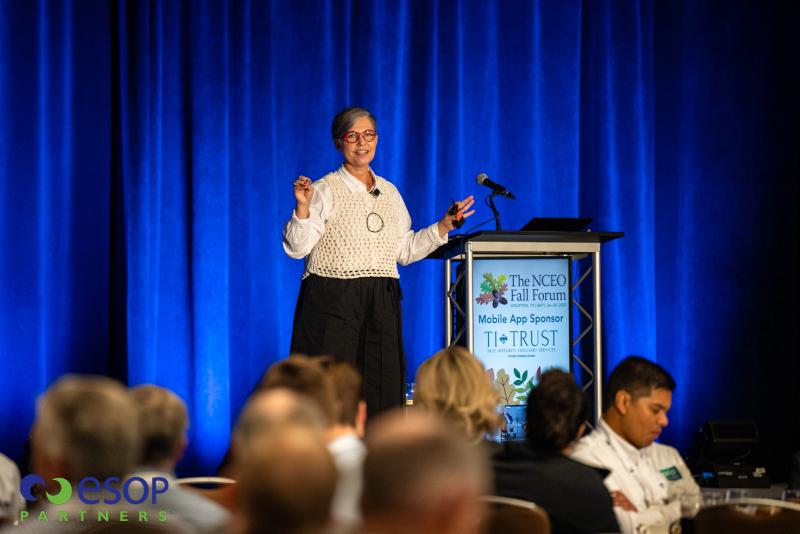The NCEO Fall Forum
ESOP as the Optimal Company Model for Secured Growth and Legacy
Leveraging the power of the ESOP model to help fuel success, NCEO provides the blueprint
In today’s fiercely competitive business landscape, companies throughout North America are on the hunt for the next big pivot that can give them the edge they need to not only survive but truly thrive in the face of relentless competition.
Over the years, companies have tested various methods like the alluring four-day workweek, unlimited vacation time, and even the classic company party to accomplish this. While these initiatives have their merits, they all pivot toward a common theme – the idea that the ultimate reward for employees is time away from work.
But is that what truly resonates with the modern workforce?
When we delve into the heart of employee priorities, we find a compelling list that includes fair compensation, robust career development, unwavering job security, a vibrant company culture, well-deserved recognition, a sense of purpose, and the ever-elusive work-life balance.
This is a multifaceted tapestry of desires that a single workforce structure has yet to fully satisfy. However, there exists a transformative solution that encapsulates all these aspirations and more. This newly emerging structure neatly packages all of the above into a powerful concept known as Employee Ownership.
Providing the roadmap to success and standing by its members, the National Center for Employee Ownership (NCEO) plays a key role in fostering awareness, growth, and education initiatives when it comes to the implementation and success of the ESOP model for its valued members. The organization’s fall conference is a forum that provides the platform necessary to help foster continued growth for the ESOP company model.
Employee Ownership From Past to Present
The roots of employee ownership in the United States trace back to the early 19th century, with its predecessors appearing as worker cooperatives and mutual aid societies. These grassroots movements were borne out of the collective desire among workers to enhance their working conditions and wield influence over the management of their workplaces.
It was in the 1970s and 80s that employee ownership truly took flight, thanks to a pivotal piece of legislation called the Employee Retirement Income Security Act (ERISA) of 1974.
ERISA laid the groundwork for Employee Stock Ownership Plans (ESOPs), offering not only enticing tax incentives but also vital protections for employees. ESOPs soon garnered bipartisan support and were heralded as a means to fortify retirement security and generate wealth within the labor force.
As the ESOP movement gathered steam, the need for dedicated advocacy and rigorous research became increasingly evident. Organizations like The ESOP Association (TEA) and the National Center for Employee Ownership (NCEO) were born from this necessity.
Today, TEA and NCEO play pivotal roles in hosting conferences, webinars, and events tailored to empower employee-owners and guide those who contemplate the transition to an ESOP.
The NCEO Fall Forum, one of their flagship events, is a prime example of the type of advocacy being displayed within the ESOP space. The event embodies the essence of employee ownership, characterized by genuine cooperation, collaboration, and integration among participants, and the result is an environment where the ESOP community flourishes.

Jaymie Oviedo, Senior Director of Events
Here, a shared commitment to treating employees right permeates every interaction. “Once you drink the employee-owned Kool-aid, it’s kind of hard to go back,” quips Jaymie Oviedo, Senior Director of Events for the NCEO.
Discussions and sessions at these gatherings span a multitude of topics, from valuation and succession planning to leadership transition, executive compensation, engagement-driving incentives, risk mitigation, and beyond.
It’s a one-stop shop for those contemplating an ESOP journey or aspiring to enhance their existing one.
Core Motivations Behind ESOP Structure Transitions
One of the driving forces behind the surge in employee ownership is the imperative to confront the Silver Tsunami.
This term references the monumental transfer of wealth and leadership looming as baby boomers approach retirement and their vast holdings in closely held and private businesses prepare to change hands.
Tim Garbinsky, Communications Director for the NCEO, emphasizes that “it’s important that this transfer isn’t a mere one-time event but rather a catalyst for enduring positive impact, benefiting not just future business leaders and owners but also the dedicated workforce and the communities they call home.”
In truth, many American companies are grappling with the critical issue of succession planning, and transitioning ownership to the very employees who helped build these businesses emerges as both an honorable legacy and, in many cases, the financially prudent choice.
Loren Rogers, Executive Director at the NCEO, encapsulates this sentiment beautifully:
“Everybody owning a business is writing a book, the book of their life. The chapter where you set up a business is a big chapter of your life, and an ESOP is what could be the starting point of the next chapter. What happens to this thing you’ve created or spent a lot of your life creating? Is that next chapter one you will feel good about, something you’re proud to tell your grandkids? If you set up a plan for your employees to become owners, then you can feel good knowing you not only have people responsible for your business who care about it and are actively preserving its character & values. But you can also feel confident that those responsible are those same people that helped you build it and are sharing in the benefit of all that you’ve built.”
However, the path to adopting an ESOP has its challenges. Careful consideration is essential, and owners must embark on a journey of due diligence.
As Steve Baker, Vice-President of the Great Game of Business, aptly puts it, there’s more than one kind of due diligence involved. It’s not just about the financial and fiduciary responsibilities or selecting the right service providers. Business owners typically desire at least a fair market value for the sale of their business, and post-transaction, the company management team needs to understand how to sustain and grow that value.”
A company’s long-term stability and subsequent scaling under this model requires its employees to transition into a business owner mindset in order for the next generation of management to lead the business forward. So, in that regard, education and mentorship are pivotal in this process.
 Support and Solutions to ESOP Challenges
Support and Solutions to ESOP Challenges
The good news is that business owners considering a transition of ownership to a trust benefiting their employees (“ESOP”) aren’t in it alone.
There are plenty of companies that specialize in aiding business owners in transitioning their business ownership over to an ESOP. These companies help with company valuation, ESOP & DOL compliance, and much more.
Among these entities stands Prairie Capital Advisors. As an ESOP, Prairie specializes in business ownership transition, and Michael McGinley, Managing Director at Prairie, shares a crucial point that all business owners should consider.
McGinley emphasizes that “every business owner needs to think about what they want their exit to look like. There is no time like the present to start thinking about how you are going to exit your business and who you want to own it next. You don’t want to be in a situation where you have to transition ownership of the business in unfavorable circumstances.”
Financing an ESOP can, at times, become another challenge to overcome. Transactions can be complex and typically entail higher costs for the company. However, avenues like the federally funded State Small Business Credit Initiative (SSBCI) are opening doors for ESOPs to expand through acquisitions or new formations.
Steve Strokin, Executive Director at the Employee Ownership Expansion Network (EOX), is eager to leverage SSBCI loans to foster more employee-owned businesses. He underscores the game-changing potential of SSBCI, stating, “An existing ESOP company can use SSBCI dollars to leverage for a loan to buy another company and make them part of their ESOP.” For Strokin, this is ideal because helping companies employ such savvy financial strategies aligns seamlessly with EOX’s mission to advance employee ownership.
Another challenge pertains to minority or women-owned businesses, as transitioning to 100% employee ownership can entail relinquishing these certifications.
However, conversations are underway with the Department of Labor and ESOP community members to explore ways to navigate this issue, allowing companies to proudly bear both employee and minority/women-owned labels.
Additionally, discussions are progressing to offer preferential treatment for federal contractors affiliated with employee-owned institutions.
So, for every challenge, organizations like the NCEO, The ESOP Association, and EOX are diligently providing resources to mitigate risks associated with employee ownership.
The Employee-Led Future of Business
The allure of being an employee-owned company is undeniable. With clear-cut advantages like S-Corp exemption from federal income tax, enabled reinvestment in the company, and a more engaged, dedicated workforce, employee ownership is looking to be the business world’s hidden gem.
Upon closer inspection of the success of other companies that have already adopted this structure, it becomes clear that the ESOP model is the secret weapon that businesses have sought without realizing its existence.
While there are hurdles to overcome, they are already being addressed by more than one entity. From a moralistic perspective, switching to a model that honors and handsomely rewards the hard work of individual employees resonates as “the right thing to do,” as Garbinsky so aptly puts it.
In conclusion, the landscape of employee ownership in America is brimming with promise. It’s a journey that has transformed workplaces, empowered individuals, and secured legacies.
It embodies the essence of shared prosperity and collective achievement, offering companies an opportunity to thrive, not just survive, in the fiercely competitive arena of modern business.
In musical terms, you could call Employee ownership a symphony of dreams, where the chorus sings in unison: “We own our destiny together.”
AT A GLANCE
The NCEO Fall Forum
What: A premier event gathering experts and enthusiasts in the field of employee-owned companies. The event provides a vibrant platform for attendees to engage, share best practices, and gain in-depth knowledge about the latest trends and strategies in employee ownership.
Where: Houston, Texas
Website: https://www.nceo.org/
PREFERRED VENDORS
Key Stone Search – www.keystonesearch.com
KeyStone has over 20 years of experience identifying and securing leaders for employee-owned companies. We have successfully worked with ESOPs all over the country to identify and hire the right executive level talent or Board Director. Our process is built specifically for ESOP companies.





